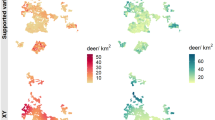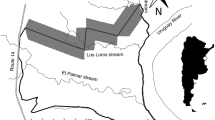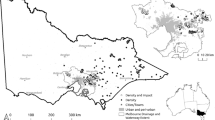Abstract
The red deer is in the Iberian Peninsula at the southwestern edge of its European range and although widespread, red deer ecology in Portugal remains poorly understood. By using pellet group counts, we investigate how habitat structure, vegetation composition and human disturbance affect red deer occurrence. Red deer distribution was positively associated with areas with high density of heather, Leguminosae plants and patches with high cover of shrubs, ground cover and tree cover. Red deer occupied areas further away from roads and from villages. Red deer distribution was negatively associated with agricultural fields and areas with high canopy cover.
In the perspective of the current climatic changes, continue research on red deer in these so-called edge populations represents an opportunity to assess the ecological responses within an evolutionary perspective and to provide important conservation suggestions for other countries located on the edge of its distribution range. The present results have implications for the conservation of red deer, emphasizing the need for wide range ecological studies. Red deer variation seems to be related to local factors rather than proximity to the edge of its range.
Similar content being viewed by others
References
Acevedo, P., Ruiz-Fons, F., Vicente, J., Reyes-García, A.R., Alzaga, V., Gortázar, C, 2008. Estimating red deer abundance in a wide range of management situations in Mediterranean habitats. J. Zool. 276, 37–47.
Apollonio, M., Andersen, R., Putman, R., 2010. European Ungulates and Their Management in the 21st Century. Cambridge University Press, Cambridge.
Bates, D., Sarkar, D., 2006. lme4: Linear Mixed-effects Models Using S4 classes. R Package Version 0.9975-10, Available at: http://cran.rproject.org/web/ packages/lme4/index.html
Boitani, L, 2000. Action Plan forthe Conservation of Wolves (Canis lupus) in Europe, vol. 113. Nature and Environment, Council of Europe Publishing, pp. 1–86.
Bonenfant, C, Loe, L.E., Mysterud, A., Landvatn, R., Stenseth, N.C., Gaillard, J.-M., Klein, F., 2004. Multiple causes of sexual segregation in European red deer: enlightenments from varying breeding phenology at high and low latitude. Proc. Biol. Sci. 271, 883–892.
Boyce, M.S., Mao, J.S., Merrill, E.H., Fortin, D., Turner, M.G., Fryxell, J.,Turchin, P., 2003. Scale and heterogeneity in habitat selection by elk in Yellowstone National Park. Ecoscience 10, 421–431.
Bugalho, M.N., Milne, J.A., 2003. The composition of the diet of red deer (Cervus elaphus) in a Mediterranean environment: a case of summer nutritional constraint? Forest Ecol. Manag. 181, 23–29.
Buuveibaatar, B., Young, J.K., Fine, A.F., 2010. Mongolian saiga in Sharga Nature Reserve: are domestic dogs a threat to saiga? Mongolian J. Biol. Sci. 7, 37–43.
Burnham, K.P., Anderson, D.R., 1998. Model Selection and Inference: A Practical Information-theoretic Approach. Springer, New York.
Carranza, J., Hidalgo de Trucios, S., Medina, R., Valencia, J., Delgado, J., 1991. Space use by red deer in a Mediterranean ecosystem as determined by radio-tracking. Appl. Anim. Behav. Sci. 30, 363–371.
Carranza, J., Mateos, C, Alarcos, S., Sánchez-Prieto, C.B., Valencia, J., 2008. Sex-specific strategies of dentine depletion in red deer. Biol. J. Linn. Soc. 93, 487–497.
Carvalho, P., Nogueira, A.J.A., Soares, A.M.V.M., Fonseca, C, 2008. Ranging behaviour of translocated roe deer in a Mediterranean habitat: seasonal and altitudinal influences on home range size and patterns of range use. Mammalia 72, 89–94.
Carvalho, J., 2011. Monitorizacão da população de veado (Cervus elaphus L.) na Zona de Caça Nacional daLombada, Nordeste Transmontano: Época 2010–2011. University of Aveiro, Portugal, pp. 123 (First degree thesis in Biology).
Clutton-Brock, T.H., Coulson, T., Milner, J.M., 2004. Red deer stocks in the Highlands of Scotland. Nature 429, 261–262.
Cole, E.K., Pope, M.D., Anthony, R.G., 1997. Effects of road management on movement and survival of Roosevelt elk. J. Wildlife Manag. 61, 1115–1126.
Collins, W.B., Urness, P.J., 1981. Habitat preferences of mule deer as rated by pellet-group distributions. J. Wildlife Manag. 45, 969–972.
Faraway, J.J., 2006. Extending the Linear Model with R: Generalized Linear, Mixed Effects and Nonparametric Regression Models. Chapman and Hall, Boca Raton, FL
Frid, A., Dill, L.M., 2002. Human-caused disturbance stimuli as a form of predation risk. Conserv. Ecol. 6, 1–16.
Godvik, I.M.R., Loe, L.E.,Vik, J.O., Veiberg,V.Ø., Langvatn, R., Mysterud, A., 2009. Temporal scales, trade-offs, and functional responses in red deer habitat selection. Ecology 90, 699–710.
Guillet, C, Bergstrom, R., Cederlund, G., Bergstrom, J., Ballon, P., 1995. Comparison of telemetry and pellet-group counts for determining habitat selectivity by roe deer (Capreolus capreolus) in winter. Gibier Faune Sauvage 12, 253–269.
Jayakody, S., Sibbald, A., Mayes, R., Hooper, R., Gordon, I., Lambin, X., 2011. Effects of human disturbance on the diet composition of wild red deer (Cervus elaphus). Eur. J. Wildlife Res. 57, 939–948.
Jiang, G., Ma, J., Zhang, M., Stott, P., 2009. Multiple spatial-scale resource selection function models in relation to human disturbance for moose in northeastern China. Ecol. Res. 24, 423–440.
Loe, L.E., Bonenfant, C, Meisingset, E.L., Mysterud, A., 2012. Effects of spatial scale and sample size in GPS-based species distribution models: are the best models trivial for red deer management? Eur. J. Wildlife Res. 58, 195–203.
Lovari, S., Cuccus, P., Murgia, A., Murgia, C, Soi, F., Plantamura, G., 2007. Space use, habitat selection and browsing effects of red deer in Sardinia. Ital. J. Zool. 74, 179–189.
Mattioli, S., Meneguz, P.G., Brugnoli, A., Nicoloso, S., 2001. Red deer in Italy: recent changes in distribution and numbers. Ital. J. Zool. 12, 27–35.
Mayle, B.A., Peace, A.J., Gill, R.M.A., 1999. How Many Deer? A Field Guide to Estimating Deer Population Size. Forestry Commission. Field Book., pp. 18.
Mayle, B.A., Putman, R.J., Wyllie, I., 2000. The use of trackway counts to establish an index of deer presence. Mamm. Rev. 30, 233–237.
Moreira, L.M., Rosa, J.L., Lourenco, J., Barroso, I., Pimenta, V., 1997. Projecto Lobo. Relatório de Progressão 1996 (Cofinanciado pela U. E. – Programa LIFE). Parque Natural de Montesinho, Bragança.
Mysterud, A., Langvatn, R., Yoccoz, N.G., Stenseth, N.C.H.R., 2002. Large-scale habitat variability, delayed density effects and red deer populations in Norway. J. Anim. Ecol. 71, 569–580.
Mysterud, A., Østbye, E., 1999. Cover as a habitat element for temperate ungulates: effects on habitat selection and demography. Wildlife Soc. Bull. 27, 385–394.
Nabuurs, G.J., 1996. Quantification of herb layer dynamics under tree canopy. Forest Ecol. Manag. 88, 143–148.
Papageorgiou, N.K., 1978. Food preferences, feed intake, and protein requirements of red deer in central Greece. J. Wildlife Manag. 42, 940–943.
Parmesan, C, Yohe, G., 2003. A globally coherent fingerprint of climate change impacts across natural systems. Nature 42, 37–42.
Patthey, P., 2003. Habitat and Corridor Selection of an Expanding Red Deer (Cevus elaphus) Population. University of Lausanne, Lausanne, Switzerland (Ph.D. The¬sis).
Phillips, G., Alldredge, E.A.W., 2000. Reproductive success of elk following disturbance by humans during calving season. J. Wildlife Manag. 64, 521–530.
Puddu, G., Maiorano, L, Falcucci, A., Corsi, F., Boitani, L., 2009. Spatial-explicit assessment of current and future conservation options forthe endangered Corsican red deer (Cervus elaphus corsicanus) in Sardinia. Biodivers. Conserv. 18, 2001–2016.
Rowland, M.M., Wisdom, M.J., Johnson, B.K., Kie, J.G., 2000. Elk distribution and modeling in relation to roads. J. Wildlife Manag. 64, 672–684.
San José, C, Braza, F., Aragón, S., Delibes, J.R., 1997. Habitat use by roe and red deer in Southern Spain. Misc. Zool. 20, 27–38.
Santos, J., 2009. Estudo populacional do veado (Cervus elaphus L.) no NordesteTransmontano. University of Aveiro, pp. 96 (M.Sc. Thesis).
Schaefer, J.A., Morellet, N., Pépin, D., Verheyden, H., 2008. The spatial scale of habitat selection by red deer. Can. J. Zool. 86, 1337–1345.
Sibbald, A.M., Hooper, R.J., McLeod, J.E., Gordon, I.J., 2011. Responses of red deer (Cervus elaphus) to regular disturbance by hill walkers. Eur. J. Wildlife Res. 57 (4), 817–825.
Stankowich, T., 2008. Ungulate flight responses to human disturbance: a review and meta-analysis. Biol. Conserv. 141, 2159–2173.
Torres, R.T., Virgós, E., Santos, J., Linnell, J.D.C., Fonseca, C, 2012a. Habitat use by sympatric red and roe deer in a Mediterranean ecosystem. Anim. Biol. 62, 351–366.
Torres, R.T., Virgós, E., Panzacchi, M., Linnell, J.D.C., Fonseca, C, 2012b. Life at the edge: Roe deer occurrence at the opposite ends of their geographical distribution, Norway and Portugal. Mamm. Biol. 77, 140–146.
Torres, R.T., Carvalho, J.C., Panzacchi, M., Linnell, J.D.C., Fonseca, C, 2011. Comparative use of forest habitats by roe deer and moose in a human-modified landscape in southeastern Norway during winter. Ecol. Res. 26, 781–789.
Venables, W.N., Ripley, B.D., 1999. Modern Applied Statistics with S-plus. Springer.
Vingada, J., Fonseca, C, Cancela, J., Ferreira, J., Eira, C, 2010. In: Apollonio, M., Andersen, R., Putman, R.J. (Eds.), Ungulates and Their Management in Portugal. European Ungulates and their Management in the 21st Century. Cambridge University Press, Cambridge.
Zachos, F.E., Hartl, G.B., 2011. Phylogeography, populationgenetics and conservation of the European red deer Cervus elaphus. Mamm. Rev. 41, 138–150.
Author information
Authors and Affiliations
Corresponding author
Rights and permissions
About this article
Cite this article
Torres, R.T., Santos, J. & Fonseca, C. Factors influencing red deer occurrence at the southern edge of their range: A Mediterranean ecosystem. Mamm Biol 79, 52–57 (2014). https://doi.org/10.1016/j.mambio.2013.09.002
Received:
Accepted:
Published:
Issue Date:
DOI: https://doi.org/10.1016/j.mambio.2013.09.002




